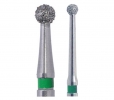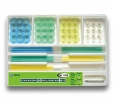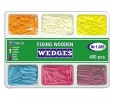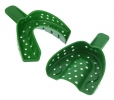|
The restoration of the edentulous jaw using fixed prostheses on implants poses a challenge for both the dentist and the patient. In the lower jaw there are the foramina mentalis, which define the distal boundary for the insertion of the implants. In the posterior areas of the atrophied lower jaw the vertical available bone is often missing over the canalis mandibulae, so that the insertion of implants of sufficient length is difficult or impossible. In the upper jaw, the sinuses allowing the insertion of implants without complex sinus elevation, often only exist up to Region 4. For a fixed bridge, a statically stable distribution of abutments with trapeze-like support of the prosthesis is often only possible in both the upper and lowerjaw with the aid of complex, lengthy and costly surgical interventions, such as augmentative procedures and / or sinus lift. Therefore, a treatment protocol is desirable that avoids this and satisfies the abovementioned wishes of the patients The treatment concept: The concept by Philippe D. Ledermann, with four interforaminal implants stabilised by a connecting bar with subsequent immediate loading by prosthesis, has been known since the mid-seventies and is well documented. Dr. Malo (Lisbon) developed later from it the wellknown therapeutic concept for the immediate restoration of the edentulous jaw with fixed bridge on four implants,under the brand name “All-on-four”®(Firm Nobel Biocare). Here, the fixed posterior 5 are positioned at an inclination of up to 45° (with the tip of the implant inclined anteriorly), so that with optimum utilization of the existing bone material a strategically more favourable abutment distribution can be made, with support in regions 5-6. Such a concept requires the development of systemic prosthetics in the form of specially angled abutments to achieve a mutual prosthetic insertion direction. The opportunities for the application of such a concept are limited to a few implant manufacturers available on the market. One such manufacturer is the company Dentegris (Germany), which provides such a concept with DAAS (Dentegris Angled Abutment System). Here workis performed on the mandible with four and on the maxilla with six implants
Objective: Objective of the treatment concept is the immediate restoration of the edentulous mandible with reduced surgical, time and financial resources. Through the avoidance of elaborate augmentation measures or a sinus lift, the treatment time can be shortened and number of sessions will be reduced. The patient should leave the practice as far as possible with fixed teeth
Requirements and Procedure: Initially, a careful preoperative diagnosis with reliable imagery of adequate available bone for abutment in the horizontal and vertical planes is essential. Besides the quantity, the quality of the bone also plays a role; because the more important parameter for immediate loading is reaching an implant insertion torque of at least 30-35 Ncm. Not every patient is therefore equally suited for this approach. In the case of indication-related suitability of the patient, during a session any remaining dentition is extracted, the implants are inserted, and an impression is taken. Immediately postoperatively, the prosthesis is manufactured and inserted in the form of a screw-retained bridge A high degree of surgical experience and close collaboration with a dental technician with experience in this field are prerequisites for successful prosthetic restoration. Here, all the varieties are possible from synthetic bridges with lowmetal content to veneered premium solutions of zirconium oxide or metal frameworks
Example: The patient came into my practice. After a clinical and radiographic examination using an orthopantomogram, Fig-1, it was quickly clear that preservation of the inadequate bridge construction of the parodontal pre-damaged dentition, partially endodontically insufficiently treated teeth and root caries in crown 21 did not come into question. Since the patient wished once again to have a fixed prosthesis, and had already gathered “experience with implants” and wanted to avoid an edentulous transitional period at all costs, after extensive consultation the DAASConcept from Dentegris was chosen. Following detailed implant anamneses and preliminary consultation, in the first session impressions were taken for the production of an anatomic cast. In the second session the extraction of the remaining dentition was performed, as was the removal of the implant in region 15, Fig-2. Inflamed tissue was carefully removed and the jaw ridge levelled. Then six implants (Soft Bone 3.75 x 13 mm, by the firm Dentegris) were inserted with the necessary torque of 35 Ncm, whereby the two posterior implants were placed at an angle of about 35-40 °, Fig-3. With the conical soft bone implants, designed with progressively strong thread from the apex, a high primary stability was achieved, so that nothing stood in the way of the immediate loading of a bridge. The radiograph clearly shows the distal angulation of the inserted implants -Fig-4 This was followed by the screwing of the special abutment with subsequent suturing.The fresh extraction alveoli not used during the implantation were filled with bovine bone replacement material (CompactBoneB., by the firm Dentegris), each was covered with a collagen membrane (BoneProtect Membrane, by the firm Dentegris) and sutured. Finally, the impression posts screwed on and stabilised with each other-Fig-5. This followed the impression taking in the open procedure. Immediately after the healing, abutments were screwed on, to avoid covering of the abutments caused by swelling of the gingiva -Fig-6
Aftera checkbite using a mushbite, the production of the screw-retained bridge was begun by the laboratory, and completed-Fig-7. Particular attention was paid to the fundamental preparation of the prosthesis, so that the gingiva, already swollen as a result of the OP was not additionally compromised. After a few hours, the bridge manufactured from synthetic material could be integrated-Fig-8-and screwed on. The prosthesis was incorporated very harmoniously into the overall picture of the mouth and face to the great satisfaction of the patient. The patient was instructed to rinse the mouth twice daily with antibacterial mouthwash until the stitches were removed - and in the first few days - to maintain a soft food diet. After this the patient could leave the practice with new, fixed teeth. In the subsequent recalls the patient received detailed care instructions (toothbrushes, interdental brushes, Super Floss) for her new prosthesis Conclusion: Using treatment concepts, such as the DAAS system can reduce the surgicaland financial costs as well as the number ofpatient visits The total treatment time is reduced significantly, since both major augmentation measures as well as sinus floor elevation can be avoided and the subsequent treatment interruptions do not apply. Through the immediate restoration and immediate loading of the implant, the traditional edentulous phase or phase with a provisional bridged implant healing phase is also eliminated. The standardised treatment protocol provides, furthermore, a very reliable cost plan. And last but not least, the patient leaves the practice on the day of the operation with fixed teeth, which is certainly a compelling argument for offering this concept to the appropriate patient for this type of implant care
|
Source: Dentegris Website








